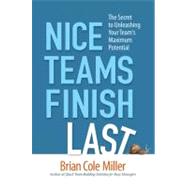
Note: Supplemental materials are not guaranteed with Rental or Used book purchases.
Purchase Benefits
What is included with this book?
BRIAN COLE MILLER (Dublin, OH) is the principal of Working Solutions, Inc., a
management training and consulting firm whose clients include WellPoint, Ohio
State University, and Nationwide Insurance. He is the author of the bestselling
Quick Team-Building Activities for Busy Managers (978-0-8144-7201-9) as well
as Keeping Employees Accountable for Results (978-0-8144-7320-7), and More
Quick Team-Building Activities for Busy Managers (978-0-8144-7378-8).
| Acknowledgments | p. vii |
| Introduction | p. ix |
| NICE Teams are...Well, NICE! | p. 1 |
| The Opposite of NICE is MEAN, isn't it? | p. 33 |
| The Sweet Spot Between NICE and FIERCE: BOLD | p. 59 |
| BOLD Principles | p. 85 |
| BOLD Feedback | p. 109 |
| BOLD Requests | p. 127 |
| BOLD Disagreements | p. 143 |
| Become BOLD | p. 161 |
| NICE Team Assessment | p. 177 |
| Team Member Style Assessment | p. 183 |
| BOLD Conversation Assessment | p. 193 |
| BOLD Feedback Planning Sheet | p. 197 |
| BOLD Request Planning Sheet | p. 201 |
| Index | p. 205 |
| About the Author | p. 209 |
| Table of Contents provided by Ingram. All Rights Reserved. |
The New copy of this book will include any supplemental materials advertised. Please check the title of the book to determine if it should include any access cards, study guides, lab manuals, CDs, etc.
The Used, Rental and eBook copies of this book are not guaranteed to include any supplemental materials. Typically, only the book itself is included. This is true even if the title states it includes any access cards, study guides, lab manuals, CDs, etc.